TANDBERG MXP User manual
- Category
- Video conferencing systems
- Type
- User manual
This manual is also suitable for

User Manual
Software version F4
D13358.06
March 2006
This document is not to be reproduced in whole or in part without permission in writing from:

TANDBERG Maestro MXP
ii
Trademarks and Copyright
All rights reserved. This document contains information that is proprietary to TANDBERG. No part
of this publication may be reproduced, stored in a retrieval system, or transmitted, in any form, or
by any means, electronically, mechanically, by photocopying, or otherwise, without the prior
written permission of TANDBERG. Nationally and internationally recognized trademarks and
trade names are the property of their respective holders and are hereby acknowledged.
Third Party Software
Amended / Expanded Copyright notices for third-party software on the TANDBERG MXP systems
are listed below:
Full copies of the licenses and warranty statements are located on the product CD in the license
files directory.
The non-commercial third party code is distributed in binary form under the terms of non-copyleft
style open source licenses such as BSD, Artistic or MIT/X Consortium.
The product also has some binary code distributed under the terms of the GNU public license
with an exemption which allows static links to non-copyleft commercial code.
In accordance with section (3) of the GNU General Public License, copies of such code will be
provided upon request by contacting TANDBERG. Please contact us by using the Online Support
section at
www.tandberg.net or the “contact us” section of this manual. Please provide USD
10.00 for media and shipping.
Agfa
Contains iType™ from Monotype Imaging Corporation.
CMU-SNMP
Copyright 1988, 1989, 1991, 1992 by Carnegie Mellon University All Rights Reserved
CMU-SNMP is distributed under the terms of the CMU SNMP license, which is an open source license similar to a BSD or
X Consortium License.
Dropbear - an SSH2 server
Copyright (c) 2002,2003 Matt Johnston All rights reserved.
The Dropbear SSH2 server is distributed under the terms of the Dropbear License, which is a MIT/X Consortium style
open source license.

User Manual
iii
eCos
eCos, the Embedded Configurable Operating System.
Copyright (C) 1998, 1999, 2000, 2001, 2002, 2003 Red Hat, Inc.
Copyright (C) 2002, 2003 John Dallaway
Copyright (C) 2002, 2003 Nick Garnett
Copyright (C) 2002, 2003 Jonathan Larmour Copyright (C) 2002, 2003 Andrew Lunn Copyright (C) 2002, 2003 Gary
Thomas Copyright (C) 2002, 2003 Bart Veer
Copyright (c) 1982, 1986, 1991, 1993 The Regents of the University of California. All rights reserved.
(c) UNIX System Laboratories, Inc.
All or some portions of this file are derived from material licensed to the University of California by American Telephone
and Telegraph Co. or Unix System Laboratories, Inc. and are reproduced herein with the permission of UNIX System
Laboratories, Inc.
Copyright (C) 1995, 1996, 1997, and 1998 WIDE Project. * All rights reserved.
Copyright (c) 2000 Brian Somers <brian@Awfulhak.org>
Copyright (c) 1998 The NetBSD Foundation, Inc. * All rights reserved.
Copyright (c) 1997 Niklas Hallqvist. All rights reserved.
Copyright (c) 1988 Stephen Deering.
Copyright (c) 1992, 1993 The Regents of the University of California. All rights reserved.
This code is derived from software contributed to Berkeley by Stephen Deering of Stanford University.
Portions of eCos code are distributed under several BSD style licenses. Other portions of eCos code are distributed under
the terms of the GNU General Public License with a non-copyleft exception which allows static links to non-copyleft
programs.
ExPat XML Parser:
Copyright (c) 1998, 1999, 2000 Thai Open Source Software Center Ltd and Clark Cooper
Copyright (c) 2001, 2002, 2003, 2004, 2005, 2006 Expat maintainers.
The ExPat XML parser is distributed under the terms of the ExPat License which is a MIT/X Consortium style open
source license
ICU
ICU License - ICU 1.8.1 Copyright (c) 1995-2003 International Business Machines Corporation and others All rights
reserved.
ICU is distributed under the terms of the ICU license, which is a MIT/X Consortium style license.
OpenSSL
Copyright (c) 1998-2004 The OpenSSL Project. All rights reserved.
This product includes software developed by the OpenSSL Project for use in the OpenSSL Toolkit
(http://www.openssl.org/)"
Copyright (C) 1995-1998 Eric Young ([email protected]) * All rights reserved.
OpenSSL is distributed under the terms of the OpenSSL and SSLeay licenses, which are both BSD style open source
licenses.

TANDBERG Maestro MXP
iv
Disclaimer
The information in this document is furnished for informational purposes only, is subject to
change without prior notice, and should not be construed as a commitment by TANDBERG. The
information in this document is believed to be accurate and reliable; however TANDBERG
assumes no responsibility or liability for any errors or inaccuracies that may appear in this
document, nor for any infringements of patents or other rights of third parties resulting from its
use. No license is granted under any patents or patent rights of TANDBERG.
This document was written by the Research and Development Department of TANDBERG,
Norway. We are committed to maintain a high level of quality in all our documentation. Towards
this effort, we welcome you to
Contact us with comments and suggestions regarding the content
and structure of this document.
COPYRIGHT © 2005–2006, TANDBERG
snprintf
Copyright 1999, Mark Martinec. [email protected] All rights reserved
Snprintf is distributed under the terms of the snprintf license, which is a Frontier Artistic style open source license.
A standard copy of snprintf can be located at the author’s web site: http://www.ijs.si/software/snprintf/
xSupplicant (wpa_supplicant) 802.1x
Copyright (c) 2002-2005, Jouni Malinen [email protected]
xSupplicant is distributed under the terms of the xSupplicant license, which is a BSD style open source license.

User Manual
v
Environmental Issues
TANDBERG visual communication products significantly reduce the need for travel and thereby
help reduce various types of pollution. TANDBERG recommends the use of low energy
peripherals, such as EnergyStar™ monitors. Thank you for buying a TANDBERG product.
Battery handling
The batteries for the Remote Control are Long Life Alkaline batteries, which means you will need
fewer batteries, further benefiting the environment. Please follow the guidelines on the packing
material for handling and disposal instructions for the batteries.
Waste handling
This TANDBERG product contains no consumables that require disposal. You should retain the
packaging materials in case future shipment is necessary. Please contact your local authorities
for information on waste handling and recycling regulations for electronic products
Production of products
Our factories employ the most efficient environmental methods for reducing waste and pollution.
Our designers do their best to ensure TANDBERG products are highly recyclable.
Digital User Manuals
TANDBERG is pleased to announce that it has replaced the printed versions of its User Manuals
with a digital CD version. Instead of a range of different user manuals, there is now one CD which
can be used with all TANDBERG MXP products. The CD contains a variety of supported
languages. The environmental benefits of digital manuals are significant, from saving paper, to
reduced weight for shipping. Even the CD itself is recyclable. Not only are they more ecological,
digital manuals are more user friendly. A simple web-based search feature helps users directly
access the information they need. In addition, this TANDBERG video system now has an intuitive
on-screen help function, which provides a range of useful features and tips. If desired, the user
manuals on the CD can still be printed locally.

TANDBERG Maestro MXP
vi
Operator Safety Summary
For your protection, please read these safety instructions completely before operating the
equipment and keep this manual for future reference. The information in this summary is intended
for operators. Carefully observe all warnings, precautions and instructions both on the apparatus
and in the operating instructions.
Equipment Markings
The lightning flash symbol within an
equilateral triangle is intended to alert the
user to the presence of uninsulated
“dangerous voltages” within the product’s
enclosure that may be of sufficient
magnitude to constitute a risk of electrical
shock.
The exclamation mark within an equilateral
triangle is intended to alert the user to the
presence of important operating and
maintenance (servicing) instructions
accompanying the equipment.
Warnings
Water and moisture - Do not operate the equipment under or near water - for example
near a bathtub, kitchen sink, or laundry tub, in a wet basement, or near a swimming pool
or in areas with high humidity.
Cleaning - Unplug the apparatus from the wall outlet before cleaning or polishing. Do not
use liquid cleaners or aerosol cleaners. Use a lint-free cloth lightly moistened with water
for cleaning the exterior of the apparatus.
Ventilation - Do not block any of the ventilation openings of the apparatus. Install in
accordance with the installation instructions. Never cover the slots and openings with a
cloth or other material. Never install the apparatus near heat sources such as radiators,
heat registers, stoves, or other apparatus (including amplifiers) that produce heat.
Grounding or Polarization - Do not defeat the safety purpose of the polarized or
grounding-type plug. A polarized plug has two blades with one wider than the other. A
grounding type plug has two blades and a third grounding prong. The wide blade or third
prong is provided for your safety. If the provided plug does not fit into your outlet, consult
an electrician.
Power-Cord Protection - Route the power cord so as to avoid it being walked on or
pinched by items placed upon or against it, paying particular attention to the plugs,
receptacles, and the point where the cord exits from the apparatus.
Attachments - Only use attachments as recommended by the manufacturer.
Accessories - Most systems should only be used with a cart, stand, tripod, bracket, or
table specified by the manufacturer, or sold with the apparatus. When a cart is used, use
caution when moving the cart/apparatus combination to avoid injury from tip-over.
Lightning - Unplug this apparatus during lightning storms or when unused for long periods
of time.

User Manual
vii
ISDN cables - CAUTION - To reduce the risk of fire, use only No. 26 AWG or larger
telecommunication line cord.
Servicing - Do not attempt to service the apparatus yourself as opening or removing
covers may expose you to dangerous voltages or other hazards, and will void the
warranty. Refer all servicing to qualified service personnel.
Damaged Equipment - Unplug the apparatus from the outlet and refer servicing to
qualified personnel under the following conditions:
When the power cord or plug is damaged or frayed
If liquid has been spilled or objects have fallen into the apparatus
If the apparatus has been exposed to rain or moisture
If the apparatus has been subjected to excessive shock by being dropped, or the
cabinet has been damaged
If the apparatus fails to operate in accordance with the operating instructions

TANDBERG Maestro MXP
viii
Contact us
If you have any questions, comments or suggestions, please see the
Online Support section at
www.tandberg.net.
It is also possible to send a fax or mail to the attention of:
Product and Sales Support
TANDBERG
P.O. Box 92
1325 Lysaker
Norway
Tel: +47 67 125 125
Fax: +47 67 125 234

User Manual
ix
Table of Contents
1 Introduction............................................................................................................................. 13
1.1 At a Glance .......................................................................................................................... 16
1.2 Menu Structure .................................................................................................................... 20
2 Installation .............................................................................................................................. 22
2.1 Unpacking and Mounting..................................................................................................... 23
2.2 Connecting Cables............................................................................................................... 25
2.3 Monitor Configuration........................................................................................................... 27
2.4 System Configuration........................................................................................................... 28
3 General Use ........................................................................................................................... 31
3.1 The Welcome Screen .......................................................................................................... 32
3.2 Using the Remote Control.................................................................................................... 33
3.2.1 Navigation................................................................................................................ 37
3.2.2 Selfview.................................................................................................................... 38
3.2.3 Layout...................................................................................................................... 40
3.2.4 Mic Off...................................................................................................................... 41
3.2.5 Volume + and -......................................................................................................... 42
3.2.6 Number and Letter keys........................................................................................... 43
3.2.7 Touch Tones............................................................................................................ 44
3.3 On-screen Indicators............................................................................................................ 45
3.4 Using the Menu.................................................................................................................... 47
3.5 Make a Call.......................................................................................................................... 49
3.5.1 Place Video Call....................................................................................................... 50
3.5.2 Place Telephone Call............................................................................................... 51
3.5.3 Add Call ................................................................................................................... 52
3.5.4 Call Settings............................................................................................................. 54
3.5.5 Streaming................................................................................................................. 55
3.6 Answer an incoming call...................................................................................................... 57
3.7 End Call................................................................................................................................ 58
3.8 Standby................................................................................................................................ 59
3.8.1 Delay Standby for 1 hour......................................................................................... 60
3.8.2 Delay Standby for 3 hours....................................................................................... 61
3.8.3 Do Not Disturb ......................................................................................................... 62
3.9 Phone Book ......................................................................................................................... 63
3.9.1 Call Log.................................................................................................................... 64
3.9.2 My Contacts............................................................................................................. 65
3.9.3 Global Contacts ....................................................................................................... 72
3.10 Camera Control.................................................................................................................. 76
3.10.1 Move Camera .......................................................................................................... 77
3.10.2 Far End Control........................................................................................................ 78
3.10.3 Camera Presets....................................................................................................... 79
3.10.4 TANDBERG Tracker................................................................................................ 80
3.10.5 Picture Control......................................................................................................... 81
3.10.6 Camera Tracking ..................................................................................................... 82
3.11 Presentation....................................................................................................................... 83
3.11.1 Presentation Key...................................................................................................... 84
3.11.2 Presentation Menu................................................................................................... 85
3.11.3 PC Presenter (DVI/VGA Input)................................................................................ 86
3.11.4 PC Soft Presenter and VNC.................................................................................... 87
3.11.5 Dual Stream (DuoVideo
TF
/H.239)............................................................................ 88
3.11.6 Take New Snapshot................................................................................................. 89

TANDBERG Maestro MXP
x
3.11.7 Display Snapshot..................................................................................................... 90
3.12 Conference Services.......................................................................................................... 91
3.12.1 Request Floor and Release Floor............................................................................ 94
3.12.2 Conference Layout................................................................................................... 95
3.12.3 Terminal Names....................................................................................................... 96
3.12.4 Chair Control............................................................................................................ 97
3.12.5 Assign Floor and Release Floor from Participant.................................................... 98
3.12.6 View Site and End View........................................................................................... 99
3.12.7 Disconnect Participant........................................................................................... 100
3.12.8 Terminate Meeting.................................................................................................101
3.12.9 More about MultiSite (embedded MCU)................................................................ 102
3.13 Control Panel................................................................................................................... 104
3.13.1 Diagnostics ............................................................................................................ 105
3.13.2 System Information................................................................................................106
3.13.3 Channel Status ...................................................................................................... 107
3.13.4 Call Status.............................................................................................................. 109
3.13.5 System Selftest...................................................................................................... 110
3.13.6 View Administrator Settings................................................................................... 111
3.13.7 IP Address Conflict Check..................................................................................... 115
3.13.8 Warnings................................................................................................................ 116
3.13.9 Text Chat ...............................................................................................................118
3.13.10 Audio Demo....................................................................................................... 119
3.13.11 Administrator Settings ....................................................................................... 120
3.13.12 Restart............................................................................................................... 121
3.13.13 User Guide ........................................................................................................ 122
4 Administrator Settings.......................................................................................................... 123
4.1 General Settings................................................................................................................ 124
4.1.1 Language............................................................................................................... 125
4.1.2 System Name ........................................................................................................ 126
4.1.3 International Name................................................................................................. 127
4.1.4 Auto Answer........................................................................................................... 128
4.1.5 Phone Book Settings ............................................................................................. 129
4.1.6 External Services Settings..................................................................................... 130
4.1.7 Permissions ...........................................................................................................131
4.1.8 Screen Settings...................................................................................................... 133
4.1.9 Software Options ................................................................................................... 139
4.1.10 Date and Time Settings ......................................................................................... 140
4.2 Menu Settings.................................................................................................................... 141
4.2.1 Input Editor Language............................................................................................ 142
4.2.2 Menu Timeout in Call............................................................................................. 143
4.2.3 Menu on TV ........................................................................................................... 144
4.2.4 Menu on PC........................................................................................................... 145
4.2.5 Balloon Help........................................................................................................... 146
4.2.6 Administrator Password......................................................................................... 147
4.2.7 Kiosk Mode Settings.............................................................................................. 148
4.2.8 Startup ................................................................................................................... 151
4.2.9 Icons....................................................................................................................... 153
4.3 Presentation Settings......................................................................................................... 154
4.3.1 Presentation Start.................................................................................................. 155
4.3.2 H.239 ..................................................................................................................... 156
4.3.3 Startup Video Source............................................................................................. 157
4.3.4 Presentation Source .............................................................................................. 158
4.3.5 Snapshot Source ................................................................................................... 159
4.3.6 Auto-Display Snapshot.......................................................................................... 160
4.3.7 PIP Appearance..................................................................................................... 161
4.3.8 PIP Placing ............................................................................................................ 162

User Manual
xi
4.3.9 VNC Settings ......................................................................................................... 163
4.4 Call Quality......................................................................................................................... 164
4.4.1 Video Algorithm...................................................................................................... 165
4.4.2 Audio Algorithm...................................................................................................... 166
4.4.3 AAC-LD 128kbps (stereo audio)............................................................................ 167
4.4.4 Natural Video......................................................................................................... 168
4.4.5 Max Upstream Rate (kbps).................................................................................... 169
4.4.6 Video Quality.......................................................................................................... 170
4.4.7 Default Call Settings .............................................................................................. 173
4.5 Audio.................................................................................................................................. 176
4.5.1 Inputs ..................................................................................................................... 177
4.5.2 Outputs .................................................................................................................. 181
4.5.3 Echo Control.......................................................................................................... 183
4.5.4 Stereo Settings ...................................................................................................... 184
4.5.5 Audio Leveling (AGC)............................................................................................ 186
4.5.6 Alert Tones and Volume ........................................................................................ 187
4.6 Video.................................................................................................................................. 188
4.6.1 Camera Tracking Mode ......................................................................................... 189
4.6.2 MCU Status Line.................................................................................................... 190
4.6.3 Floor to Full Screen................................................................................................ 191
4.6.4 Web Snapshots...................................................................................................... 192
4.6.5 MultiSite Picture Mode........................................................................................... 193
4.6.6 Video Name........................................................................................................... 195
4.7 Security.............................................................................................................................. 196
4.7.1 Encryption.............................................................................................................. 197
4.7.2 Encryption Mode....................................................................................................198
4.7.3 Passwords .............................................................................................................199
4.8 Network.............................................................................................................................. 200
4.8.1 ISDN/External/Leased E1/T1................................................................................. 201
4.8.2 LAN Settings.......................................................................................................... 211
4.8.3 Network Profiles..................................................................................................... 227
4.8.4 Data Port................................................................................................................ 228
4.8.5 Restore Default Settings........................................................................................ 229
5 Peripheral Equipment........................................................................................................... 230
5.1 Interfaces ........................................................................................................................... 231
5.1.1 Video...................................................................................................................... 231
5.1.2 Audio...................................................................................................................... 235
5.1.3 Network.................................................................................................................. 236
5.1.4 Data port................................................................................................................ 242
5.2 Document Camera............................................................................................................. 243
5.3 DVD / VCR......................................................................................................................... 244
5.4 Additional Cameras............................................................................................................ 245
5.5 Additional Microphones...................................................................................................... 246
5.6 The TANDBERG DNAM and Speakers............................................................................. 248
5.7 Stereo Speaker Kit............................................................................................................. 252
5.8 Telephone Add-On............................................................................................................. 254
5.9 Dual Monitor....................................................................................................................... 255
5.10 XGA Monitors and Projectors .......................................................................................... 256
5.11 VESA Display Power Management................................................................................. 257
5.12 Digital Monitor Power Management................................................................................. 258
5.13 Extended Display Identification Data (EDID)................................................................... 259
6 Appendices........................................................................................................................... 261
6.1 Appendix 1......................................................................................................................... 262
6.2 Appendix 2......................................................................................................................... 265
6.3 Appendix 3......................................................................................................................... 268
6.4 Appendix 4......................................................................................................................... 269

TANDBERG Maestro MXP
xii
6.5 Appendix 5......................................................................................................................... 270
6.6 Appendix 6......................................................................................................................... 273
6.7 Appendix 7......................................................................................................................... 274
6.8 Appendix 8......................................................................................................................... 275
6.9 Appendix 9......................................................................................................................... 276
6.10 Appendix 10..................................................................................................................... 277
6.11 Appendix 11..................................................................................................................... 278
6.12 Appendix 12..................................................................................................................... 281
6.13 Appendix 13..................................................................................................................... 283
6.14 Appendix 14..................................................................................................................... 284
6.15 Appendix 15..................................................................................................................... 286
6.16 Appendix 16..................................................................................................................... 291
7 Glossary ............................................................................................................................... 292
8 Index..................................................................................................................................... 301

1 Introduction
The TANDBERG Maestro MXP provides high-end performance features, large monitors and
precision audio. This creates a collaborative meeting environment for medium to large-sized
meeting rooms.
Audio Quality
High-performance audio provides a richer, more complete visual communication experience. The
MPEG4 AAC-LD standard is used to provide true standards-based CD-quality, stereo audio.
The Digital Natural Audio Module
TM
(DNAM), specifically designed for videoconferencing, provides
higher fidelity sound for more natural sounding spoken-word. The DNAM features 250W of
power.
Users can record and send stereo audio from stereo presentation and playback sources using
PCs, DVDs and VCRs using the proper cables.
NEW Eliminate disturbance from GSM mobile phones and Blackberry devices
Video Quality
Features which ensure high quality video include:
Natural Video
TF
which provides a 60 fields per second true interlaced picture.
Support for H.264 in MultiSite, DuoVideo/H.239 and encryption.
SXGA input and 2 x XGA output through DVI-I (analog or digital).
WAVE II (Wide Angle View) Camera that delivers the widest angle of view in the industry.
H.264 video compression up to 2Mbps.
Support for native 16:9 Wide XGA monitors by increasing the resolution to 1280x768
(WXGA).
Automatic use of WXGA format when ”VGA Monitor Format” is set to Wide.
NEW High Definition (HD) Support on all TANDBERG MXP systems with a DVI input
and output
NEW High quality video and native 16:9 formats
Network
The system supports videoconferencing via both IP and ISDN networks. The bandwidth
capabilities are:
up to 4Mbps* on IP
up to 2Mbps* on ISDN
up to 6Mbps* IP in MultiSite.
SIP support, for both point-to-point and MultiSite*.
If channels are dropped during a videoconferencing session, downspeeding
TF
automatically
maintains connections without interruption.

TANDBERG Maestro MXP
14
Security
Secure Conference
TF
provides embedded encryption for both Point-to-Point and MultiSite call and
ensures both privacy and security.
The system is delivered with integrated Expressway™ firewall traversal technology. When used
together with a TANDBERG Border Controller it enables:
Secure and seamless traversal of ANY firewall.
No missing features when traversing the firewall – works with H.264, MPEG4 audio,
encryption.
Outside systems, such as home offices, to be part of the enterprise dial plan.
Dialing to systems by URI, e.g. [email protected].
NEW
H.460, ITU Standardized firewall traversal, support
NEW
High security network authentication (802.1x)
MultiSite*
The optional embedded MultiSite
TF
functionality can connect up to 6 video sites and 5 audio sites.
Embedded MultiSite
supports screen layouts such as VoiceSwitched, AutoSplit, 4 Split and 5+1 Split. The optional
embedded MultiSite functionality supports any combination of ISDN and IP participants in a
conference (up to the total).
Superior quality and reliability in MultiSite calls is ensured by the systems support for:
DuoVideo/H.239 to provide for presenting full PC resolution information
AES and DES encryption to provide security
H.264 video algorithm to provide the best video at all bandwidths
Rate matching
TF
to support different call rates for all sites in a MultiSite
Transcoding
TF
to support different protocols for all sites in a MultiSite.
The TANDBERG videoconferencing system can also be used as an audio telephone bridge
(assuming ISDN connection(s)).
Presentations
The Natural Presenter Package* (NPP) makes it possible to include PC presentations in
videoconferences and comprises:
Digital Clarity
TF
which transmits exceptionally high-quality, native resolution video.
Duo Video
TF
/H.239 which allows participants at the far end to simultaneously watch a
presenter on one screen and a live PC presentation in native resolution on a second
monitor (up to SXGA on compatible monitors).
PC Presenter
TF
which allows a PC connection via standard DVI/VGA cable supporting up
to SXGA resolution.
PC SoftPresenter
TF
which shows PC images via a LAN connection supporting XGA
resolution.
Auto Layout to automatically choose the best layout for the call.
PC Zoom which allows the native resolution PC image to be zoomed in/out with the
remote control to get SXGA resolution.

Installation
15
Users can display video and presentations in the best layout based on the situation. Supported
screen layouts are:
Picture in Picture (PiP)
Picture outside Picture (PoP)
Side by Side
User interfaces
A web-interface to the codec provides:
System management, diagnostics and software uploads.
Text chat/closed captioning.
Unicast Streaming – which allows broadcasting of audio/video via an IP network to a
single compatible client (RealMedia™ or Apple Quicktime™) or streaming server.
The On-Screen Menu:
Provides an easy interface for first-time users with symbols and descriptions.
Builds upon the familiar current interface.
NEW
Enhanced language support with Asian and non-Latin character text input in the
menu for local language system names
NEW
Support for new optional remote control
improved usability
separate ordering
NEW Simplified on-screen menu, Kiosk Mode, for special purposes
The remote control has a simplified look and feel, an auto system wake-up when picked up, and
large, easy-to-read keys.
Interoperability
The TANDBERG Maestro MXP is worldwide compatible with other ITU standards-based
videoconferencing systems from many other vendors worldwide.
* - optional feature. To check which options are installed, select Control Panel - Diagnostics - System Information in the
menu.
TF
- TANDBERG First

TANDBERG Maestro MXP
16
1.1 At a Glance
WAVE II Camera
The main camera is mounted on top of the product. The main camera includes a high quality
color camera with a fast pan/tilt/zoom action. The main camera is controlled by the system’s
infrared remote control and operates pan/tilt, focus and zoom. Up to fifteen camera positions can
be pre-stored using Camera Presets.
A locking mechanism fixates the camera on top of the product. To release the locking mechanism
and remove the camera push the grey button on the rear end of the camera stand

Installation
17
Internal LCD Display
The system has a built-in 5inch LCD designed to optimize system configuration and give the user
access to menus and test video signals without attaching or powering an external display device.
The LCD gives full control of all system settings and status. Below the LCD there are three
system indicators, one red light indicating that the system is powered, one yellow light indicate
that a call is active, and one green light indicate that the table microphones are muted.
External display
The TANDBERG Maestro is designed to give unlimited flexibility on the choice of display
technologies and solutions to display video, and is an ideal solution for large meeting rooms
which already are equipped with e.g. front projector and screen. For transferring video signal to
one or more external display devices the Codec has the following video outputs:
- DVI-I analog or digital interface
- XGA
- MiniDin, S-video
- RCA / Phono, Composite video
The usage of S-video gives the best quality for showing video of a far end, and use of DVI-I and
XGA gives the best quality at PC presentation. Read user manual on the display device for
configuration of settings at external display to meet setting at the Codec.
Codec
The codec is the heart of the system. Its main task is the compression of outgoing video, audio
and data, the transmission of this information to the far end and the decompression of the
incoming information - the name codec comes from a combination of the two words compression
and decompression.
The system is easily movable with four wheels and one handle. The codec is located inside the
pedestal and behind the codec cover, which is easy removable. The pedestal stands on a solid
base with an access hatch on the rear. On the inside of the hatch there are pockets for storing
remote control and microphones. Pull the hatch to open. Inside the base there is room for
additional equipment, e.g. a VCR/DVD, and for storage of cables. The Digital Natural Audio
Module is built into the pedestal.
Remote Control
The remote control is used to control all functions of the system. If the screen saver is activated
(black monitor), touching the remote control will automatically wake up the system. The remote
control uses 4 AAA batteries. The system will tell you when batteries are running low. Change the
batteries at the back of the remote control.

TANDBERG Maestro MXP
18
The reach of the remote control signal is 20 meters. For users sitting in an open plan office, this
can cause problems. Use the little, white switch placed under the batteries to change the reach of
the signal from 20 meters to 2 meters. This will prevent you from unintentionally controlling
another video system, when you control your own system.
Microphone
The high quality table microphone is designed to be placed on a table during a videoconference.
Up to three microphones can be connected. The ideal location for the microphone is on a flat
surface at least 2m (6.5 ft) from the front of the system. The microphone cable should always
point towards the system. The system will automatically equalize sound levels. Loud and soft
voices are picked up and transmitted to the far end at approximately the same level.
Digital Natural Audio Module
The Digital Natural Audio Module (DNAM) is designed to enhance the audio quality during a
videoconference. The DNAM provides natural sounding audio, as if the person or another sound
source in the conference is present in the same room as you.
The DNAM is a frequency-compensated sound system optimized for voice and other sounds that
appears in modern videoconferencing. It is designed and dedicated specifically for
videoconferencing requirements. The use of the highest quality speaker elements as well as
proper amplifier- and software techniques minimizes signal distortion.
The system will automatically detect the DNAM and optimize the audio output. Once detected the
audio output will be in digital format (S/PDIF). The DNAM supports both analog and digital input.
The DNAM amplifier and speaker cabinet are integrated directly into the Maestro pedestal.

Installation
19
TANDBERG Tracker
The tracker is a small infrared remote control device made
to steer the camera to any desired location within the
room. Typically, several trackers would be used with each
system.
Each tracker has two buttons:
One Single person button to point the camera at a
specific person/location.
One Group button to point the camera at all
participants.
Beneath the battery in the tracker, there is a switch, which
can be set to 16 different positions between 0 and F. For
camera preset 10 to 15, the numbers A to F should be
selected.
For more information, contact your local TANDBERG
representative.

TANDBERG Maestro MXP
20
1.2 Menu Structure
The menu structure is divided into two parts. The Main Menu is available for all users and
contains all the functionality of the system. The Administrator Menu contains all the settings of the
system. The Administrator Settings are accessible from the Main Menu by selecting Control
Panel and Administrator Settings. Making changes to the Administrator Settings will change the
behavior of the system. The menu structure for Main Menu and Administrator Settings is shown
below.
Page is loading ...
Page is loading ...
Page is loading ...
Page is loading ...
Page is loading ...
Page is loading ...
Page is loading ...
Page is loading ...
Page is loading ...
Page is loading ...
Page is loading ...
Page is loading ...
Page is loading ...
Page is loading ...
Page is loading ...
Page is loading ...
Page is loading ...
Page is loading ...
Page is loading ...
Page is loading ...
Page is loading ...
Page is loading ...
Page is loading ...
Page is loading ...
Page is loading ...
Page is loading ...
Page is loading ...
Page is loading ...
Page is loading ...
Page is loading ...
Page is loading ...
Page is loading ...
Page is loading ...
Page is loading ...
Page is loading ...
Page is loading ...
Page is loading ...
Page is loading ...
Page is loading ...
Page is loading ...
Page is loading ...
Page is loading ...
Page is loading ...
Page is loading ...
Page is loading ...
Page is loading ...
Page is loading ...
Page is loading ...
Page is loading ...
Page is loading ...
Page is loading ...
Page is loading ...
Page is loading ...
Page is loading ...
Page is loading ...
Page is loading ...
Page is loading ...
Page is loading ...
Page is loading ...
Page is loading ...
Page is loading ...
Page is loading ...
Page is loading ...
Page is loading ...
Page is loading ...
Page is loading ...
Page is loading ...
Page is loading ...
Page is loading ...
Page is loading ...
Page is loading ...
Page is loading ...
Page is loading ...
Page is loading ...
Page is loading ...
Page is loading ...
Page is loading ...
Page is loading ...
Page is loading ...
Page is loading ...
Page is loading ...
Page is loading ...
Page is loading ...
Page is loading ...
Page is loading ...
Page is loading ...
Page is loading ...
Page is loading ...
Page is loading ...
Page is loading ...
Page is loading ...
Page is loading ...
Page is loading ...
Page is loading ...
Page is loading ...
Page is loading ...
Page is loading ...
Page is loading ...
Page is loading ...
Page is loading ...
Page is loading ...
Page is loading ...
Page is loading ...
Page is loading ...
Page is loading ...
Page is loading ...
Page is loading ...
Page is loading ...
Page is loading ...
Page is loading ...
Page is loading ...
Page is loading ...
Page is loading ...
Page is loading ...
Page is loading ...
Page is loading ...
Page is loading ...
Page is loading ...
Page is loading ...
Page is loading ...
Page is loading ...
Page is loading ...
Page is loading ...
Page is loading ...
Page is loading ...
Page is loading ...
Page is loading ...
Page is loading ...
Page is loading ...
Page is loading ...
Page is loading ...
Page is loading ...
Page is loading ...
Page is loading ...
Page is loading ...
Page is loading ...
Page is loading ...
Page is loading ...
Page is loading ...
Page is loading ...
Page is loading ...
Page is loading ...
Page is loading ...
Page is loading ...
Page is loading ...
Page is loading ...
Page is loading ...
Page is loading ...
Page is loading ...
Page is loading ...
Page is loading ...
Page is loading ...
Page is loading ...
Page is loading ...
Page is loading ...
Page is loading ...
Page is loading ...
Page is loading ...
Page is loading ...
Page is loading ...
Page is loading ...
Page is loading ...
Page is loading ...
Page is loading ...
Page is loading ...
Page is loading ...
Page is loading ...
Page is loading ...
Page is loading ...
Page is loading ...
Page is loading ...
Page is loading ...
Page is loading ...
Page is loading ...
Page is loading ...
Page is loading ...
Page is loading ...
Page is loading ...
Page is loading ...
Page is loading ...
Page is loading ...
Page is loading ...
Page is loading ...
Page is loading ...
Page is loading ...
Page is loading ...
Page is loading ...
Page is loading ...
Page is loading ...
Page is loading ...
Page is loading ...
Page is loading ...
Page is loading ...
Page is loading ...
Page is loading ...
Page is loading ...
Page is loading ...
Page is loading ...
Page is loading ...
Page is loading ...
Page is loading ...
Page is loading ...
Page is loading ...
Page is loading ...
Page is loading ...
Page is loading ...
Page is loading ...
Page is loading ...
Page is loading ...
Page is loading ...
Page is loading ...
Page is loading ...
Page is loading ...
Page is loading ...
Page is loading ...
Page is loading ...
Page is loading ...
Page is loading ...
Page is loading ...
Page is loading ...
Page is loading ...
Page is loading ...
Page is loading ...
Page is loading ...
Page is loading ...
Page is loading ...
Page is loading ...
Page is loading ...
Page is loading ...
Page is loading ...
Page is loading ...
Page is loading ...
Page is loading ...
Page is loading ...
Page is loading ...
Page is loading ...
Page is loading ...
Page is loading ...
Page is loading ...
Page is loading ...
Page is loading ...
Page is loading ...
Page is loading ...
Page is loading ...
Page is loading ...
Page is loading ...
Page is loading ...
Page is loading ...
Page is loading ...
Page is loading ...
Page is loading ...
Page is loading ...
Page is loading ...
Page is loading ...
Page is loading ...
Page is loading ...
Page is loading ...
Page is loading ...
Page is loading ...
Page is loading ...
Page is loading ...
Page is loading ...
Page is loading ...
Page is loading ...
Page is loading ...
Page is loading ...
Page is loading ...
Page is loading ...
Page is loading ...
Page is loading ...
Page is loading ...
Page is loading ...
Page is loading ...
Page is loading ...
Page is loading ...
Page is loading ...
Page is loading ...
Page is loading ...
Page is loading ...
Page is loading ...
Page is loading ...
Page is loading ...
-
 1
1
-
 2
2
-
 3
3
-
 4
4
-
 5
5
-
 6
6
-
 7
7
-
 8
8
-
 9
9
-
 10
10
-
 11
11
-
 12
12
-
 13
13
-
 14
14
-
 15
15
-
 16
16
-
 17
17
-
 18
18
-
 19
19
-
 20
20
-
 21
21
-
 22
22
-
 23
23
-
 24
24
-
 25
25
-
 26
26
-
 27
27
-
 28
28
-
 29
29
-
 30
30
-
 31
31
-
 32
32
-
 33
33
-
 34
34
-
 35
35
-
 36
36
-
 37
37
-
 38
38
-
 39
39
-
 40
40
-
 41
41
-
 42
42
-
 43
43
-
 44
44
-
 45
45
-
 46
46
-
 47
47
-
 48
48
-
 49
49
-
 50
50
-
 51
51
-
 52
52
-
 53
53
-
 54
54
-
 55
55
-
 56
56
-
 57
57
-
 58
58
-
 59
59
-
 60
60
-
 61
61
-
 62
62
-
 63
63
-
 64
64
-
 65
65
-
 66
66
-
 67
67
-
 68
68
-
 69
69
-
 70
70
-
 71
71
-
 72
72
-
 73
73
-
 74
74
-
 75
75
-
 76
76
-
 77
77
-
 78
78
-
 79
79
-
 80
80
-
 81
81
-
 82
82
-
 83
83
-
 84
84
-
 85
85
-
 86
86
-
 87
87
-
 88
88
-
 89
89
-
 90
90
-
 91
91
-
 92
92
-
 93
93
-
 94
94
-
 95
95
-
 96
96
-
 97
97
-
 98
98
-
 99
99
-
 100
100
-
 101
101
-
 102
102
-
 103
103
-
 104
104
-
 105
105
-
 106
106
-
 107
107
-
 108
108
-
 109
109
-
 110
110
-
 111
111
-
 112
112
-
 113
113
-
 114
114
-
 115
115
-
 116
116
-
 117
117
-
 118
118
-
 119
119
-
 120
120
-
 121
121
-
 122
122
-
 123
123
-
 124
124
-
 125
125
-
 126
126
-
 127
127
-
 128
128
-
 129
129
-
 130
130
-
 131
131
-
 132
132
-
 133
133
-
 134
134
-
 135
135
-
 136
136
-
 137
137
-
 138
138
-
 139
139
-
 140
140
-
 141
141
-
 142
142
-
 143
143
-
 144
144
-
 145
145
-
 146
146
-
 147
147
-
 148
148
-
 149
149
-
 150
150
-
 151
151
-
 152
152
-
 153
153
-
 154
154
-
 155
155
-
 156
156
-
 157
157
-
 158
158
-
 159
159
-
 160
160
-
 161
161
-
 162
162
-
 163
163
-
 164
164
-
 165
165
-
 166
166
-
 167
167
-
 168
168
-
 169
169
-
 170
170
-
 171
171
-
 172
172
-
 173
173
-
 174
174
-
 175
175
-
 176
176
-
 177
177
-
 178
178
-
 179
179
-
 180
180
-
 181
181
-
 182
182
-
 183
183
-
 184
184
-
 185
185
-
 186
186
-
 187
187
-
 188
188
-
 189
189
-
 190
190
-
 191
191
-
 192
192
-
 193
193
-
 194
194
-
 195
195
-
 196
196
-
 197
197
-
 198
198
-
 199
199
-
 200
200
-
 201
201
-
 202
202
-
 203
203
-
 204
204
-
 205
205
-
 206
206
-
 207
207
-
 208
208
-
 209
209
-
 210
210
-
 211
211
-
 212
212
-
 213
213
-
 214
214
-
 215
215
-
 216
216
-
 217
217
-
 218
218
-
 219
219
-
 220
220
-
 221
221
-
 222
222
-
 223
223
-
 224
224
-
 225
225
-
 226
226
-
 227
227
-
 228
228
-
 229
229
-
 230
230
-
 231
231
-
 232
232
-
 233
233
-
 234
234
-
 235
235
-
 236
236
-
 237
237
-
 238
238
-
 239
239
-
 240
240
-
 241
241
-
 242
242
-
 243
243
-
 244
244
-
 245
245
-
 246
246
-
 247
247
-
 248
248
-
 249
249
-
 250
250
-
 251
251
-
 252
252
-
 253
253
-
 254
254
-
 255
255
-
 256
256
-
 257
257
-
 258
258
-
 259
259
-
 260
260
-
 261
261
-
 262
262
-
 263
263
-
 264
264
-
 265
265
-
 266
266
-
 267
267
-
 268
268
-
 269
269
-
 270
270
-
 271
271
-
 272
272
-
 273
273
-
 274
274
-
 275
275
-
 276
276
-
 277
277
-
 278
278
-
 279
279
-
 280
280
-
 281
281
-
 282
282
-
 283
283
-
 284
284
-
 285
285
-
 286
286
-
 287
287
-
 288
288
-
 289
289
-
 290
290
-
 291
291
-
 292
292
-
 293
293
-
 294
294
-
 295
295
-
 296
296
-
 297
297
-
 298
298
-
 299
299
-
 300
300
-
 301
301
-
 302
302
TANDBERG MXP User manual
- Category
- Video conferencing systems
- Type
- User manual
- This manual is also suitable for
Ask a question and I''ll find the answer in the document
Finding information in a document is now easier with AI
Related papers
-
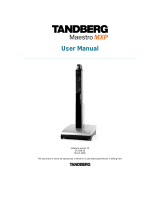 TANDBERG Maestro MXP User manual
TANDBERG Maestro MXP User manual
-
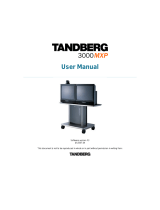 TANDBERG 3000 MXP Profile User manual
TANDBERG 3000 MXP Profile User manual
-
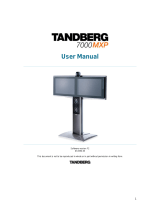 TANDBERG 7000 MXP User manual
TANDBERG 7000 MXP User manual
-
TANDBERG 6000 MXP User manual
-
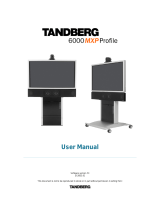 TANDBERG 6000MXP User manual
TANDBERG 6000MXP User manual
-
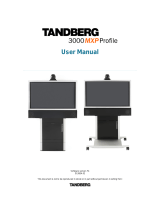 TANDBERG F730 User manual
TANDBERG F730 User manual
-
TANDBERG 1000 MXP User manual
-
TANDBERG 1000 MXP User manual
-
 TANDBERG 3000 MXP Profile User manual
TANDBERG 3000 MXP Profile User manual
-
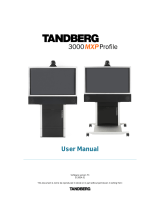 TANDBERG 3000 MXP Profile User manual
TANDBERG 3000 MXP Profile User manual
Other documents
-
Panasonic 75/85/95 MXP User manual
-
Cisco TRC5 User manual
-
Radio Shack PLVIN65 User manual
-
Intellisystem IT-FHD-MR60 Owner's manual
-
Eizo FDF2304W-IP Owner's manual
-
Eizo FDF2304W-IP Owner's manual
-
Eizo FDF2304W-IP Owner's manual
-
OTON TECHNOLOGY KC400 User manual
-
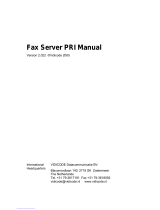 Vidicode Fax Server PRI User manual
Vidicode Fax Server PRI User manual
-
Eizo FDF2304W-IP Owner's manual





















































































































































































































































































































